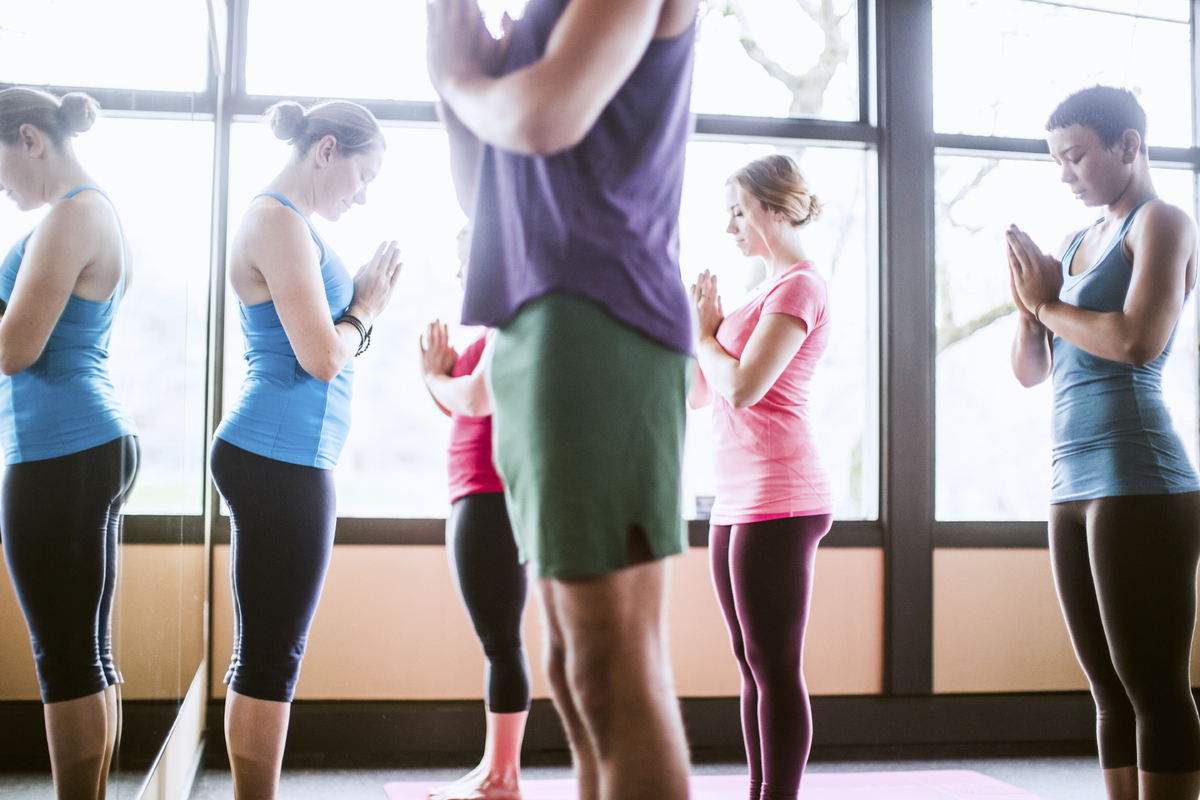You may joke that your job is slowly killing you, but it might actually be true.
And while job-related stress seems like the main culprit when it comes to health and your career ( it can have negative health effects as far ranging as increased heart attack risk, depression or premature aging), there’s another danger lurking in the office: Sitting.
“Sitting is the new smoking,” warned Wired magazine earlier this year. And indeed research links a highly sedentary lifestyle with a shorter life span and increased risk of chronic diseases like heart disease and diabetes, among other serious health problems.
As most desk jockeys know (and feel), sitting over a keyboard for hours can contribute to tightness in the hips and legs, in addition to neck, shoulder and back pain and discomfort. Camping out all day at a desk can also create an unhealthy posture — that you take with you when you leave for the day — in which the back and shoulders hunch down and the neck protrudes forward.
“There are a lot of very negative physical reactions created when the body’s not in movement,” Vyda Bielkus, certified yoga instructor and founder of Health Yoga Life studio in Boston, tells The Huffington Post. “Between sitting eight hours a day and then being in the elevator looking at your smartphone, you’re totally misaligning the spine.”
Yoga postures that target areas of tension can be an effective antidote to many desk-job ailments, according to Bielkus. And, as an added bonus, mind-body practice may help address the damaging stress of a high-pressure job by helping to calm the mind and quiet racing thought patterns.
“Yoga allows us to tap into the space between our thoughts, into our quiet mind and our awareness,” Bielkus says. “That’s what helps us gain perspective that stress is a choice — I can react with ease or I can react with stress and anxiety. Yoga helps us create some distance from our reactions.”
Here are 12 asanas to help undo the damage created by long days spent sitting at a desk.
Downward-Facing Dog (Adho Mukha Svanasana)
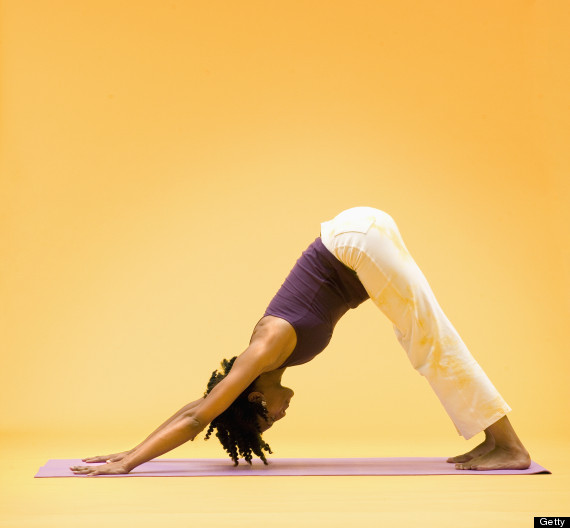
If you only do one yoga pose after a long day at work, make it a downward-facing dog, a holistic pose that stretches and strengthens many parts of the body. To come into the pose, move into an inverted “V’ shape. With hands outstretched in front and you, lift the hips and ground the feet (at about hips-width apart) into the floor. Ground all the fingers into the floor and point them forward, bring your attention to the breath as you enjoy the stretch for 30-60 seconds.
“It helps you lengthen and strengthen muscles in the body,” Bielkus says. “It reduces tension in the shoulders, relaxes the neck, and lets a little more blood flow get to the brain. You’re also able to really stretch the legs, so if you’re sitting all day, the legs are getting inactive.”
The pose is also great for stretching out the wrists and hands, which may become sore or tired from hours of typing.
Mountain Pose (Tadasana)
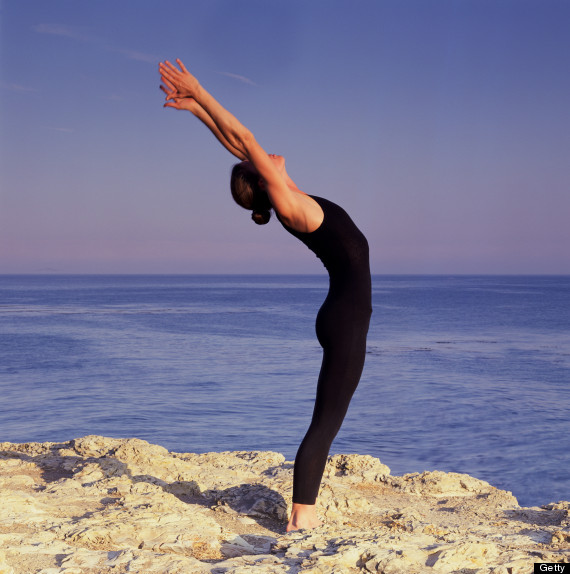
Counter a long day of contracting the back with this powerful back and chest-opening posture. Come to a comfortable standing position with feet hips-width apart, bring your hands up over your head with palms facing forward and thumbs hooked as you bend gently backwards and breathe deeply.
“This is a powerful pose to free up tight chest muscles,” Bielkus says.
Fish Pose (Matsyasana)
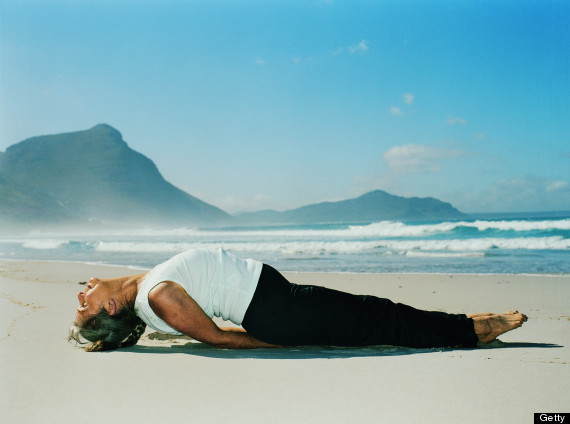
Fish pose is an excellent tension reducer, and can also be therapeutic for fatigue and anxiety, according to Yoga Journal. To come into the pose, sit up on your hips with legs stretched out together in front of you and toes pointed. Bring your hands under your hips and lean back to prop yourself up on your forearms. Then, lift the chest above the shoulders and drop the head back to the ground behind you. Breathe deeply and rest in the pose for 15-30 seconds.
Fish pose “releases tension in the neck, throat, and head, helps stretch the chest muscles and opens up the lungs,” Bielkus says.
Standing Forward Fold (Uttanasana)

A forward bend provides a soothing feeling of release — making the pose therapeutic for stress and anxiety — and with the added arm bind, this standing forward bend variation provides a deep shoulder stretch as well.
Stand with your feet at hips-width distance, and slowly bend forward from the hips to come into the forward bend. To take the strain off the lower back, bend the knees slightly. Then, try adding an arm bind to stretch the shoulders: Interlace your hands at the lower back and stretch the arms over your head and hands towards the ground in front of you. For those with tight shoulders, hold a belt between your hands, allowing the shoulders to get a deep but less intense stretch.
“By binding the hands, you also allow the arms to stretch and tight shoulders to relax,” Bielkus says. “After sitting all day, it’s a great idea to turn your world upside down and bring some blood back to the brain while getting a great stretch for the legs.”
Cat & Cow Pose (Marjaryasana & Bitilasana)
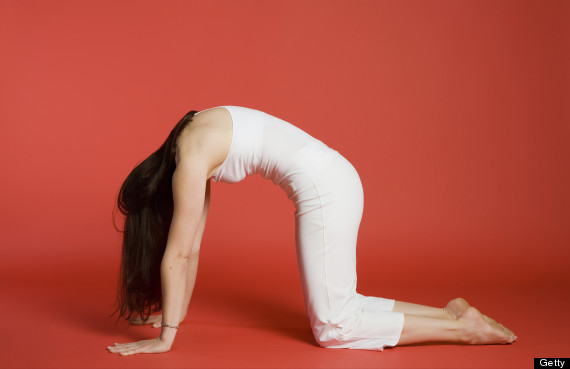
Cat-cow tilts can be an effective headache reliever, in addition to opening up the back and stretching the spine. Start with hands and knees on the floor in a tabletop position with a neutral spine. On the inhale, round the spine and curve up into your cat pose (pictured above). On the exhale, arch the back and lift the chest to come into a cow pose. Repeat three to five times, focusing on the breath.
“It also helps bring the neck back into the position over the spine — people tend to protrude it forward, and this pose brings the vertebrae back to homeostasis,” Bielkus says.
Bound Angle Pose (Baddha Konasana)

This pose helps to open the hips and ease sciatica discomfort that can be made worse by sitting for long periods.
Sit up tall with the soles of the feet touching and knees spreading open, bringing the feet in toward the pelvis and clasping your hands around your feet. Flap the knees up and down several times like butterfly wings, then sit still and focus the weight of the hips and thighs into the floor, easing pain in the sciatic nerve.
“The sciatic nerve starts in the lower back and runs down both leg, and sciatic nerve pain can occur when the nerve is somehow compressed,” Bielkus says. “Long commutes and sitting for long periods of time exacerbates it.”
Slow Neck Stretches
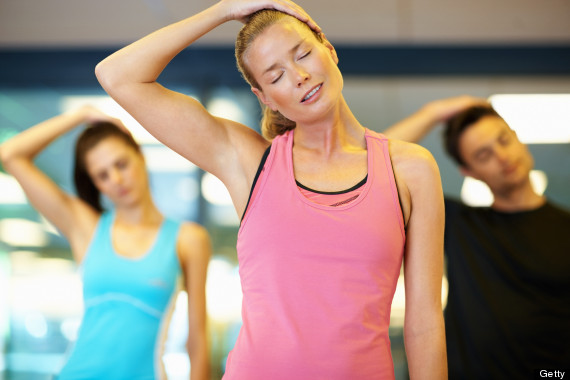
To counter neck discomfort from staring down at a keyboard or phone, Bielkus recommends a few repetitions of yogic slow neck stretches.
Sitting in a cross-legged pose, lean the head to the right and extend the left arm and hand toward the ground until you feel a deep stretch on the left side of the neck. Breathe deeply and hold for a few breath cycles, repeating on the other side. You can also try standing in Mountain Pose and stretching the neck to one side, gently pulling with the same hand.
“This can also easily be done standing anywhere, even in a cubicle,” she says. “It eases neck tension and strain.”
Cobra Pose (Bhujangasana)
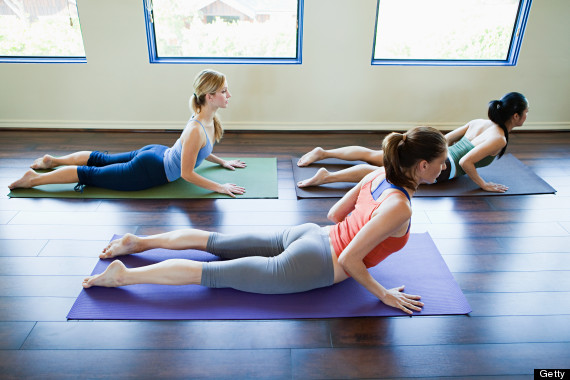
“This pose is an accessible back bend for most people,” Bielkus says. “It lengthens the spine, opens up the chest and counteracts sitting hunched over all day.”
Lying on the floor, put your hands on the ground slightly in front of you and tuck the elbows into the chest. Push up into your hands, lifting into a slight backbend and drawing the shoulders down. Turn your gaze upwards, and try not to take any tension into the face or jaw.
Half Pigeon Pose (Eka Pada Rajakapotasana)
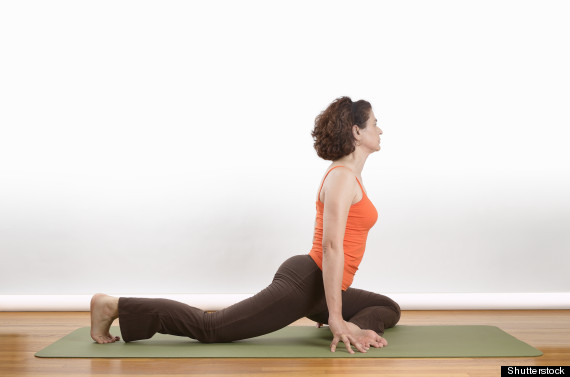
The hips can get tight from long hours of sitting. To improve flexibility and range of motion in the hips, and open up the chest and shoulders, try a half pigeon pose. Start on your hands and knees in a tabletop position, sliding the right knee forward and left leg back, as pictured above, trying to bend the front leg at a 90-degree angle. Sit up tall, and on the exhale, hinge the chest forward and bring the arms out in front of you to feel a deep stretch.
“A half pigeon is great for opening up the hips,” Bielkus says.
If you’re particularly tight in the hips, try rolling up a blanket under the hips and sitting upright, and then gently hinging forward.
Child’s Pose (Balasana)
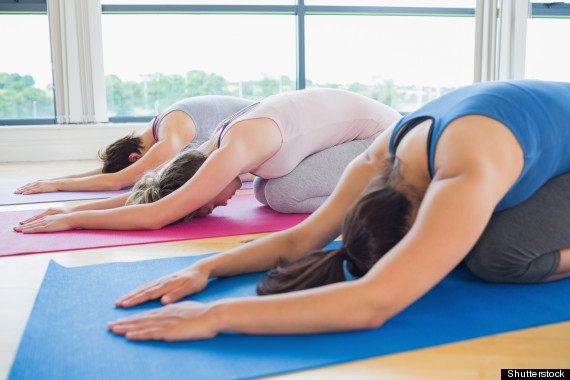
“Child’s pose helps us turn inside and slow our minds down,” Virayoga founder Elena Brower recently told The Huffington Post.
The foundational resting pose in many yoga classes, the soothing Child’s Pose can help put the mind at ease while also gently opening up the back, hips and shoulders, according to Bielkus.
Sit down with your legs folded beneath you, toes touching and knees spread apart from each other. Drape your chest down between your thighs, bringing your forehead to the floor and either extending the arms out in front of you or resting them by your sides. Breathe deeply and rest in the pose for as long as desired.
Happy Baby Pose (Ananda Balasana)
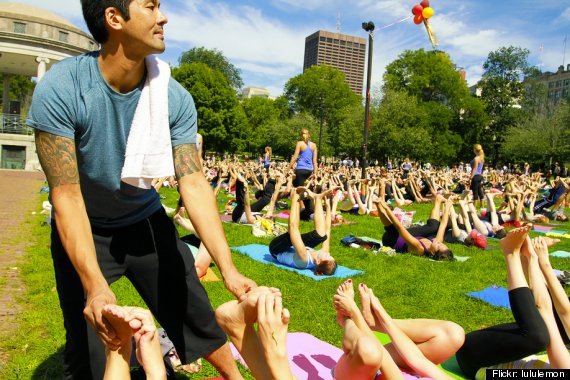
“This pose opens the hips and groins and is very calming for the mind and body,” Bielkus says.
Happy Baby Pose is accessible even for beginners, but still provides an excellent stretch for the hip joints, which can get stiff from too much sitting. Lie down on your back, draw the knees into your chest and grab your feet from the inside, pulling them down so the knees extend on either side of your torso. If the stretch is too intense, grab behind your thighs. Try to bring the hips down to the floor. Breathe deeply and rock gently side to side, returning to stillness at your center for 30 seconds.
Sitali Breathing
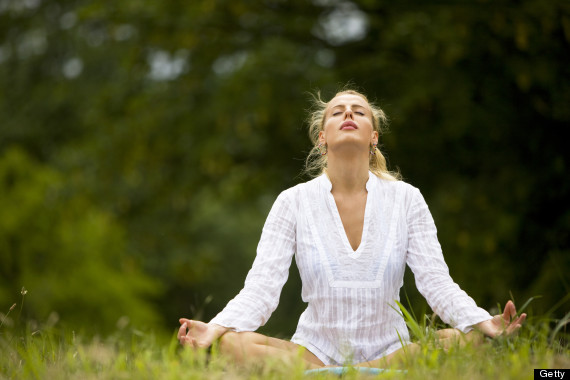
This cooling breath is the perfect antidote to a long, stressful day. “It releases tension in body and mind, and helps us relieve stress and anger and brings us to a more balanced and clear state,” she says.
To perform this refreshing pranayama exercise, sit in a chair or on the floor in an easy crossed-legged position with your eyes closed. Stick your tongue out and curl up its outer edges. (If you’re having trouble tongue curling, try your best and form a slight “O” with the mouth). Inhale through the mouth, letting the air pass over the tongue, feeling a cool breath, and then exhale through your nose.
“Continue long rhythmic breathing for three minutes,” Bielkus says. “You’ll feel totally refreshed!”
From: The Huffington Post

